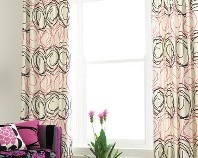Color Advice for My Friends
 June 10, 2008
June 10, 2008  Irwin Weiner ASID -- On any given week, I'm asked at least three questions by friends, family, and clients regarding color. "What color should I make the walls in this room?" "What color goes best with this style of furniture?" "What color scheme will look great 15 years from now, without driving me crazy or boring me?"
Irwin Weiner ASID -- On any given week, I'm asked at least three questions by friends, family, and clients regarding color. "What color should I make the walls in this room?" "What color goes best with this style of furniture?" "What color scheme will look great 15 years from now, without driving me crazy or boring me?"
I generally hesitate to steer people to large paint stores or paint companies, like Benjamin Moore, Sherwin Williams, or the Martha Stewart Colors paint line. Most people think this is where they should go first for color inspiration. But it's a bad idea. There is simply too much choice. Although the colors themselves may be great, the selection is overwhelming.
 It's like walking into a gigantic supermarket and saying, okay, now what do I make for dinner?
It's like walking into a gigantic supermarket and saying, okay, now what do I make for dinner?
Instead, I recommend selecting color from a fabric, a movie, a magazine picture, or other inspiration; it's easier to relate to as you can see a mood, atmosphere, and context for using colors in specific combinations.
Here are some other color tips, hints, suggestions, and overall advice regarding choosing color for your home. Please share them with your friends!
European Fabrics Can Inspire You. I think a great scarf from Hermes or an expensive necktie from Etro -- or any number of European fabrics -- can inspire your color scheme in any room. I advise going for an unusual set of color combinations that appeal to your taste. Imagine describing to your best friend what your color scheme is. If you're saying, "I'm doing my room in beige, blue, and brown," it's easy to visualize, but you risk your interior being boring and typical. Now imagine you're looking at a French scarf or a vintage Italian dress and you've got another description for your friend: "Well, the scheme is coral, teal, purple, and gray." If it sounds weird to you, I predict it will be great! Be brave with color. As we say in our Design2Share videos, be brave and err on the side of European taste as they have a strong and fanciful color sense.
 Consider Color Intensity. Usually the more intense the color, the less area it will cover in a room. Think of the man in a gray suit with a red tie. That's a very classic and traditional combination. But consider the man in a red suit with a gray tie. That's very daring! There are opposing sides to every color scheme, and depending on the intensity of the colors, you will likely have one bolder and one tamer scheme, depending on how you prioritize your use of the more intense colors. Select whichever scheme best suits you.
Consider Color Intensity. Usually the more intense the color, the less area it will cover in a room. Think of the man in a gray suit with a red tie. That's a very classic and traditional combination. But consider the man in a red suit with a gray tie. That's very daring! There are opposing sides to every color scheme, and depending on the intensity of the colors, you will likely have one bolder and one tamer scheme, depending on how you prioritize your use of the more intense colors. Select whichever scheme best suits you.
Take Your Room's Temperature. Be sensitive to the "temperature" of your color scheme. Typically, one keeps the color scheme within the same temperature. Blues, grays, greens, and black are cool colors. Yellows, oranges, reds, browns, and so on tend to be warm colors. When using white with these schemes, the shade of white you choose (yes, there are zillions of white shades!) should be either cool or warm, too. A safe bet is to select a white with a slight tint of the adjacent color mixed into it. Benjamin Moore, for instance, has a section of whites that's clear to see in which direction each white "shades off." I recommend avoiding pure white as it tends to be far too strong and glaring for a room.
Use Color For Best Effect. Color is a strong and inexpensive tool for decorating any room or area of your home, but use it with a good degree of thought behind it. Typically, many people paint the trim or molding in a room white. That's fine, but it's not a hard-and-fast rule. Here are two examples where that rule should be broken:
-
A small entry hallway with many doors will look busy and claustrophobic if all the doors and trim are painted white, contrasting with a wall color. Paint the entry door white and all the others to match the walls. That way, the front door is seen as a focal point.
-
If the ceiling is low in any room, painting the base and crown moldings the same color as the walls will make the walls look taller -- and that illusion of height is what you want to achieve.
 Color Contrasts Add Punch. Like night and day, sweet and sour, yin and yang, colors should be considered as contrasts to one another. This way, your color scheme can create interest and drama. Visualize an all-white room, with white walls, ceilings, and floors. This room might be quite calm and restful, but it might also bore you to tears. Now visualize your all-white room with a black floor and a punch of black accents in the furnishings and upholstery. Contrasting colors can make all the difference.
Color Contrasts Add Punch. Like night and day, sweet and sour, yin and yang, colors should be considered as contrasts to one another. This way, your color scheme can create interest and drama. Visualize an all-white room, with white walls, ceilings, and floors. This room might be quite calm and restful, but it might also bore you to tears. Now visualize your all-white room with a black floor and a punch of black accents in the furnishings and upholstery. Contrasting colors can make all the difference.
Use Linens For Bedroom Color Schemes. Your bed is a huge upholstered focal point in your bedroom, children's room, or guest bedroom. Select a fun set of linens as a basis for your room's color scheme. Textile designers are incredibly skilled at combining colors in clever ways to make them really stand out. Select one of the colors for the walls, another for the floor, and so on. Select the floor color(s) first as there are fewer choices to make with carpeting, rugs, and floor treatments versus the zillions of paint colors and wall coverings available. My recommendation is to buy two sets of linens for your bed in case one gets worn or damaged. You might also want to alternate linen color schemes every-other week for variety; if that's your choice, pick complimentary color schemes in your linens that will inspire the rest of the bedroom's color choices.

Go To The Movies. One particularly fun source of color inspiration for your home is at the movies. Yes, you can definitely go to Pottery Barn, The Company Store, and Anthropologie, or look at other merchandisers, catalogers, and shelter magazines for color inspiration. But sometimes movies can be a fun and stylish inspiration for your decoration. How many boys and girls bedrooms will be given an Asian twist because everyone in the family loved Kung Fu Panda? The Austin Powers movies inspired an entire generation of go-go retro-look bedrooms and color schemes with acid colors and metallics.

Atonement was a beautifully styled and designed movie in 2007 that inspired many homeowners to go with the 1930s look of mixing chintz, antiques, and floral patterns made popular by designers Sibyl Colefax and John Fowler; and the acid green color that Atonement's set designers added to their interiors to help create that over-ripe summer feeling (see photo above) made a lasting impression on many moviegoers. But whatever floats your boat -- you may find inspiration in Iron Man's metallic superhero suit! Go to the movies -- or read catalogs and shelter magazines and visit interior design merchandisers -- and get inspired to use colors in exciting and brave ways in your home.
 Design2Share's Irwin Weiner ASID had a children's room featured in the December 2007 issue of Architectural Digest.
Design2Share's Irwin Weiner ASID had a children's room featured in the December 2007 issue of Architectural Digest.
Go to Rooms of Their Own: Flights of Fancy to the Ultimate Hideaway, 11 Spaces Just for Children
Visit Irwin's IWI website to review his work and interior design services.
Photo credits: Jill Denton, Javno, Momoy, Apartment Therapy, Film In Focus

















